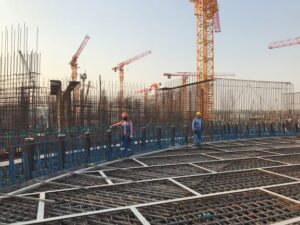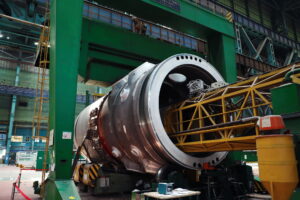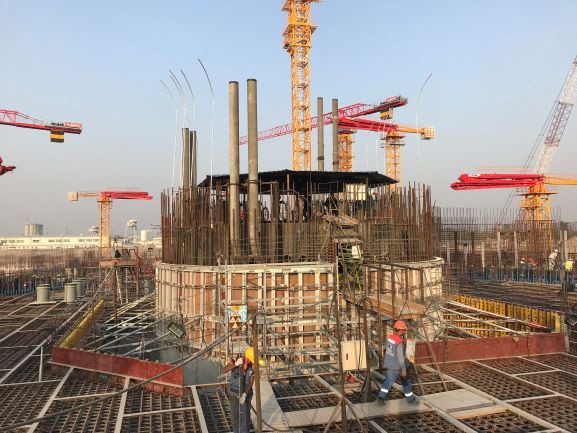The Rooppur Nuclear Power Plant is a 2.4 GWe nuclear power plant in Bangladesh. This nuclear power plant is being constructed at Rooppur (Ruppur), in Ishwardi, on the bank of the river Padma. It will be the country’s first nuclear power plant, and the first of two units are expected to go into operation by 2023. The VVER-1200/523 Nuclear reactor and critical infrastructure are being built by the Russian Rosatom State Atomic Energy Corporation. ‘Non-critical’ infrastructure is being built by Bangladeshi and Indian construction companies such as the MAX Group of Bangladesh and the Hindustan Construction Company of India.
Hindustan Construction Company Ltd. (HCC), in the joint venture with MAX Group, was awarded US$ 110 million (Rs.737 crore) contract by Russia’s State Nuclear Company, JSC Atomstroyexport, for civil works of Turbine Island for Unit 1 of Rooppur Nuclear Power Plant. MAX Group is. HCC’s share in the JV is 40% (US$ 44 million / Rs.295 crore). The scope of work includes civil works for Turbine Island of Unit 1, normal operation power building and erection works.
CONSTRUCTION
In 2016 ground preparation work was commenced. The two units generating 2.4 GWe are planned to be operational in 2023 and 2024. Rosatom will operate the units for the first year before handing over to Bangladeshi operators.
Atomenergomash is the engineering division of Russia‘s state nuclear corporation, Rosatom. This company is the supplier of all the equipment for the reactor compartment of Rooppur Nuclear Power Plant and a significant part of the equipment for the machine room.
AEM Technologies is manufacturing the internals for the RPV, as well as the reactor lid and the upper block.
ROSATOM is building two 1200MWe VVER-1200 units at Rooppur, which is on the eastern bank of the river Ganges.
More than 2,200 employees are at work at the site, including 450 Russian specialists. In the main construction period, the total number of employees will reach 12,500, including 2,500 specialists from Russia. Over 70 tenders have been issued for ‘non-critical’ works where Bangladeshi and Indian construction companies can participate.
In 2018, the first concrete was poured for Unit 2. Thereafter, Rosatom began installing a 200-tonne core catcher as the first large piece of equipment in the reactor building of Rooppur 1, describing it as “a unique protection system”.
WELDING ACTIVITIES
Unit 1 – Welding

In 2020, the Volgodonsk branch of AEM Technologies successfully completed the closing weld that connected the two halves of the reactor pressure vessel (RPV) being manufactured for unit 1 of the Rooppur nuclear power plant.
The operation lasted for ten days with continuous heating of the weld zone – from 150 to 300 degrees Celsius. During this time, about two tons of flux and more than one and a half tons of wire were used. After welding, the RPV weighing 320 tons was heated to 300 degrees and, using a crane, transferred to the furnace for two days of heat treatment. The next stage was quality control operations including x-ray flaw detection, ultrasound and capillary control inspections.
Unit 1 – Steam Generator welding
Atommash has performed the fit up and welding of a set of steam generators for Unit 1 of Rooppur NPP. Steam Generator is a heat exchanger. It is a part of reactor plant and belongs to products of the first safety class. The diameter is more than 4 m, the length of the apparatus is about 15 meters, weight – 340 tons. The equipment of one nuclear power unit includes four steam generators.
Previously, the vessel of the steam generator was assembled from four shells and welded together. In the welding process, more than 2,000 kg of flux and more than 12,000 meters of wire were used in total.
Atommash was incharge of 4 more steam generator vessels for Rooppur NPP second unit at different stages of manufacturing.
Unit 1 – hydraulic tests completed
Atommash has completed hydraulic tests on the reactor pressure vessel (RPV) of unit 1 of the Rooppur nuclear power plant under construction for Bangladesh.
A watertight chamber, or caisson, was used for the hydraulic tests, during which a maximum pressure of 24.5 MPa was generated in the RPV 1.4 times higher than the operating pressure. A crane with a lifting capacity of 600 tonnes was used to lower the 11-meter RPV into the caisson. The test welded joints of the RPV.
Welding of RPV for RNPP’s Unit-2
Rosatom has welding the upper semi-vessel of the reactor pressure vessel, or RPV, for Unit-2 of Rooppur Nuclear Power Plant (RNPP) in the Volgodonsk branch of ‘AEM-technology’ in Russia.
Following test assembly of components of the RPV semi-vessel, two shells and a flange of it were put together.
With the help of a crane, they were lifted to a welding stand for welding under heating at a temperature of 150-300 degrees celsius. It was then heated up to 300 degrees in the welding zones.
With the help of a bridge crane with a lifting capacity of 180 tonnes, it was moved into the furnace to conduct HT for four days. Simultaneously, manufacturing of lower semi-vessel consisting of three shells and a bottom was in progress. The reactor represents a vertical cylindrical body with an elliptical bottom. It hosts the core and the internals. On top, it is sealed with a cover with drives mechanisms and regulating devices installed on it for the protection of the reactors. It has nozzles, intended for passage of sensor cables of conducting in-core monitoring.
In the upper part of the vessel, there are nozzles for the coolant input and output, as well as nozzles for emergency supply of the coolant if the circuit is depressurized.
SAFETY
VVER-1200/523 is one of the latest Generation III+ nuclear reactor. Design feature of the nuclear reactor is layered safety barriers preventing escape of radioactive material. The reactor has five layers:
- Fuel pellets: Radioactive elements are retained within the crystal structure of the fuel pellets.
- Fuel rods: The zircaloy tubes provide a further barrier resistant to heat and high pressure.
- Reactor shell: a massive steel shell encases the whole fuel assembly hermetically.
- Core catcher: A core catcheris a device provided to catch the molten core material (corium) of a nuclear reactor in case of a nuclear meltdown and prevent it from escaping the containment building.
- Reactor building: A concrete containment buildingis the last line of defence. It prevents escape of radiation. It also protects from external damages.
The nuclear part of the plant is housed in a single building acting as containment and missile shield. Besides the reactor and steam generators this includes an improved refueling machine, and the computerized reactor control systems. Likewise, protected in the same building are the emergency systems, including an emergency core cooling system, emergency backup diesel power supply, and backup feed water supply.
A passive heat removal system had been added to the VVER-1200. The system is based on a cooling system and water tanks built on top of the containment dome. The passive systems handle all safety functions for 24 hours, and core safety for 72 hours.
Other new safety systems include aircraft crash protection, hydrogen recombiners, and a core catcher to contain the molten reactor core in the event of a severe accident.
LATEST
Belarus shows interest in Rooppur power plant
Belarus, a former republic of the Soviet Union, has shown interest to be involved with Bangladesh’s nuclear power plant project in Rooppur. It is eager to sign an agreement with Bangladesh in this regard.
Belarus’ deputy industries minister Dmitry Kharitonchik said that the first phase of nuclear power construction has been completed in Belarus. They have made reactors and Bangladesh is interested in Belarus’ experience. “We also want to learn about Bangladesh’s experience regarding power plants,” he said. He said, “We have not discussed the matter of constructing the actual power plant because this is a task for specialized companies. We have basically talked about how a suitable and effective infrastructure should be and how to ensure optimum usage of power.” The deputy minister stressed the safety aspect of the nuclear power plant.
For More Info :
www.rosatom.ru
www.hccindia.com
www.rooppurnpp.gov.bd








